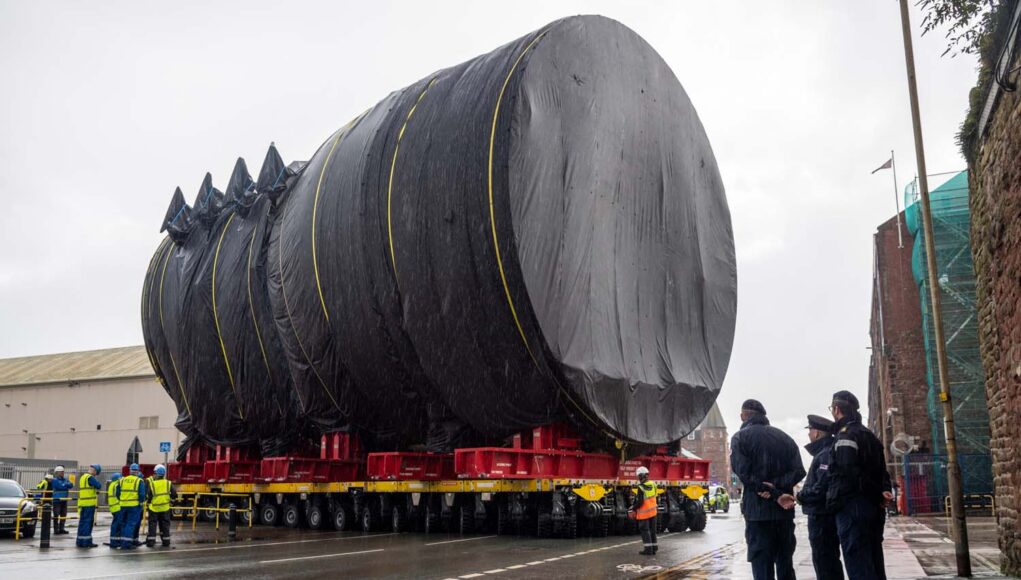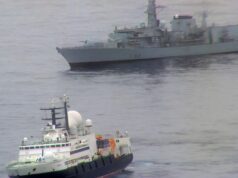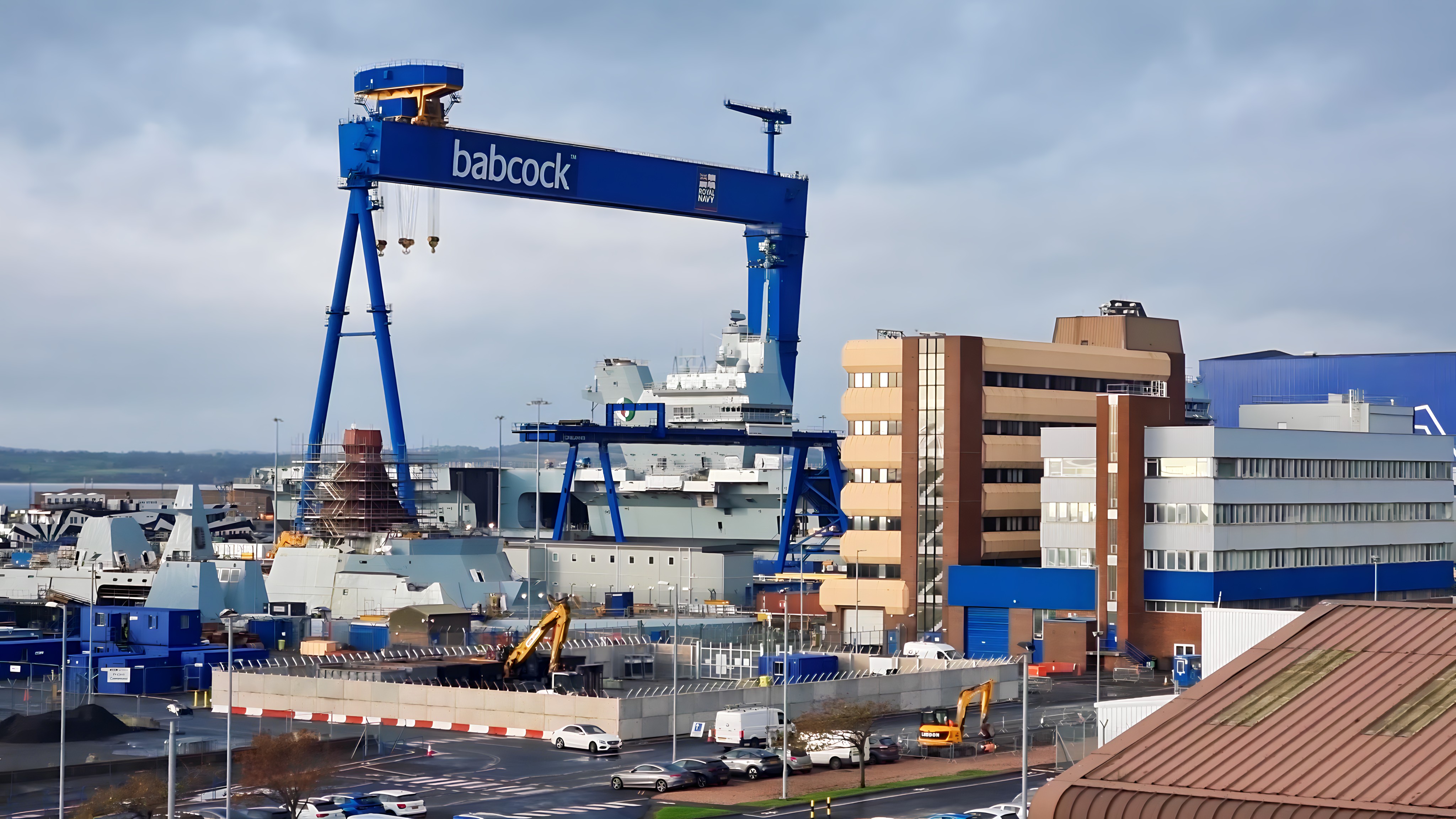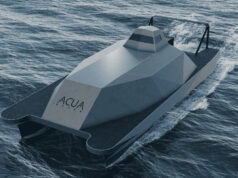A huge section of HMS Dreadnought is on the move.
This section of the first of the Dreadnought class strategic deterrent boats is the largest segment or ‘mega unit’ of Dreadnought yet completed.
The Royal Navy say here that it’s also the longest section of a submarine moved through the streets of Barrow-in-Furness from BAE Systems’ fabrication facility to the cavernous Devonshire Dock Hall which dominates the skyline of the Cumbrian town.
“No-one at BAE Submarines has moved a submarine section of this size (22 metres long) in 30 years, when a low-loader carefully transported the 34-metre-long fore-end ‘mega unit’ of HMS Vengeance, the last of the Vanguard-class submarines.
With those beginning to near the end of their active lives, four successors will be built, of which Dreadnought leads the way, ahead of HMS Warspite and Valiant (also under construction), with work yet to start on Boat No.4, HMS King George VI.”
All will be assembled under cover in the dock hall – 260 metres long, 58 wide and 51 high, making it almost large enough to accommodate the Titanic – where the final two Astute-class submarines, HMS Agamemnon and Agincourt, are in the later stages of construction/completion, and where the ‘mega unit’ will take its place on the Dreadnought build line.
Dreadnought is due to enter service in the early 2030s while the V-boats begin retiring after four decades carrying out Operation Relentless, the UK’s strategic deterrence mission.














That’s some low-loader. I like the way it’s been wrapped in bin bags to keep it dry…
The bin bags were on offer in Home Bargains £1 per roll, but BAE don’t want you to know that because they charged the MoD a huge amount of money for a Dihydrogen Monoxide defense shield.
Plus the bin bags are required to be compatible with the Mk41 VLS (FFBNW)
Yes if it gets wet it apparently rusts, let’s hope it’s a problem they can solve.
Perhaps they could use carbon fibre to make the hull? Oh wait I think some tried that already.
Fitted for, but not with
Caption competition: “I didn’t know they made black bin bags that big”..I know, I did tell them it’s never going to fit in the wheelie bin”
Lol – they get the black plastic off rolls, the sort that farmers use to wrap up the post-harvest straw into huge cylindrical jobbies. Or sillage.
Because this is military, the MoD will have issued a spec for the black plastic. Thickness +/- 0.005mm, yield +/- 0.0025kg/cm, width +/- 0.01m. There will of course be a colour swatch target on the black, with “light, dark and medium”, laboratory sampling and testing (the results of which will of course be classified) and signed off by 35 MoD civil servants plus a trainee
“polyproplene, black, 1km rolls, submarines for the use of”
Of course, the high spec and military application will attract a premium price, say £150 per square metre when the farmers prolly pay only £12 for the whole roll…..
Do you work near Filton by any chance? 😉
Ah, but you missed short term UV resistance and confirmation of maintenance of infrared reflectance properties over the weekend.
The UV resistance and IR reflectance specs only apply to the yellow drawstrings. Which are from a different supplier in Moldova, who lends his secluded holiday home to a Tory ex cabinet minister
lol with the MOD running a 10 year £35 million pound research programme to investigate the best possible colour, thickness, resistance to wear and resistance to weather degradation of the plastic wrap rolls- only to then determine the original cheap farming black plastic rolls available from Radways at £50 a 250m roll was the best option.
MOD declare the programme to have been a success “we have learnt great things about the production, tensile strength of plastic rolled sheeting and will ensure these lessons are carried forward to future projects”.
😀
Sadly there will probably be a specification for this, signed off by MOD. Having spent all my working life in either the military or defence industry, if I was MinDef for the day, the first thing I would do is cancel DE&S
I’ll ask Mr Gulliver to throw his Coke can directly in the landfill next time.
The MOD is receiving its storage unit to keep the paperwork of Ajax faults in. Never to see the light of day again.
BAE bring out the champagne bucket for the shareholders meeting.
Why do I get the feeling that this being gently accelerated as much as possible?
I wouldn’t be surprised
Hopefully a bit more than gently accelerated. Hopefully rapidly and urgently accelerated. We need the yards cleared and construction begun asap on AUKUS subs/ SSNR.
I was thinking more along the lines of getting them into service to avoid expensive LIFEX on the V boats.
Shades of T23 and all that.
I wouldn’t think you are far from the mark there. Any acceleration in their construction however small can only benefit SSN(R) production surely?
We have three A boats past their sell by dates between 2035-41, so, I imagine it’s in everyone’s interests to accelerate Dreadnaught construction.
This hull section is for the last of the 4 dreadnoughts
So they have 2 Astutes and parts of 3 Dreadnoughts in final or intial build
Don’t think so. The article says:
A huge section of HMS Dreadnought is on the move.
This section of the first of the Dreadnought class strategic deterrent boats is the largest segment or ‘mega unit’ of Dreadnought yet completed
Read it again , this is a quote
FORE END
In this picture of Vanguard in the final assembly hall in 1990s shows the hull section- FORE of the sail – has a smaller diameter. They could be different for Dreadnoughts but they are so wide that the nose sections have to get smaller
https://www.19fortyfive.com/2022/02/vanguard-meet-the-royal-navys-powerful-nuclear-missile-submarines/
I seems we are talking about 2 different things. I was meaning the section being moved is boat 1 not 4.
As per @MS below, No it isn’t for Hull 4, it’s part of hull 1. Work on hull 4 hasn’t even begun yet, and won’t for several years, most likely after Astute hull 7 is out of the shed, so early 2027 perhaps.
Duker it’s Dreadnought section E/F, at present there are the last 2 Astutes in build / fitting out and Dreadnought in build inside the Devonshire Assembly Hall.
Actually defining when a build starts is not simple. Long lead parts for all the Dreadnoughts have been being ordered, built and stored for years.
I’ve visited Barrow a few times over the years and the inside of the Devonshire hall with 3 Astutes being assembled at the same time was jaw dropping.
I really hope things are speeding up and plans are being worked out how to build the astute replacements quicker and perhaps easier.
Will there be much scope for an extension to the astutes life? I think they are 25 years design? Another 5 possible with a refit?
If a 25 year reactor is not used or just ticking over some of that 25 years does that mean the reactor life can be added on the end in simple terms? Obviously pipe corrosion etc is a separate issue.
Morning MS, the Astute design life of 25 years is for the reactor core not the hull.
Reactor core life is measured in Effective Full Power Hours (EFPH), once you reach the limit that’s it, you need more fuel, or in this case it would be a refit which was centred on re-fuelling. As we know the Astutes aren’t scheduled(designed) with this in mind, so when they reach the end of their ‘core’ life that should be it irrespective of how many refits they have had.
They have the same core as the Vanguard’s, and her refit didn’t really go well, for a whole host of reasons. One of which was a lack of suitably qualified personnel to conduct the re-fuelling. As we aren’t in the re-fuelling business anymore, we will be in that position again when Astute reaches her sell by date no later than 2035.
Our SMs don’t run around in the Full Power State that often, normally only on sea trials for a few hours to record a boats top speed and to make sure everything works fine. Despite the time I’ve served, I’ve only been in the FPS twice for a prolonged period, once was for about 13 days on out hasty transit to the Falklands back in the day, the other was for something else.
When the first Dreadnought was commissioned with a US Westinghouse reactor, her initial core life was 10000 EFPH before requiring a re-fuelling (open source Westinghouse reactors). Our SSNs spend most of the time running around in either the half or three quarter power states, whilst our SSBNs spend virtually all their time in the half power state. The power state you are in determines what RPM are available, so, the half power state broadly equates to half the maximum speed available.
Obviously modern cores use far richer yields then Dreadnought had available, so I have no idea what the EFPH of modern cores are, but the A boats are being run very hard, so wouldn’t expect them to go past there stated design life, intact I’d be surprised if they made it that far.
Thanks for the expert opinion.
Interesting about the astute life span.
So the folks that refitted the reactor on vanguard don’t have another reactor to refit so skills will be lost unfortunately.
Hopefully the SSNR will be able to expand numbers. The subs are really one of the best things the navy can have.
Really hopeful the navy get back up to 12 boats. More would amazing. Being able to have roughly 4-6 at sea makes a big difference. 1-2 for carriers, 1 for other escort/amphibious ops and a couple doing other things is great.
The unmanned subs in the coming decades is another exciting development.
Are you factoring in the effects of different mass when comparing the lifespan of the H cores fitted in the earlier PWR2 for Vanguards to the later varients fitted in the Astutes ?
No, as I wouldn’t know what the differences are.
However, its slightly irrelevant as any difference between Vanguard (X) and Astute (Y), will still be measured in EFPH available. Astutes may well have more hours to play with, but then again, they are worked far harder then a SSBN is.
The 25 year ‘core’ life attributed to the Astutes is only an estimate anyway, based on a perceived running/maintenance (reactor crtitical/shut down) cycle over the course of its life.
As the V boats have demonstrated-disregarding Vanguard, that they can go on for longer, they have been running for between 24-28 years, with more required until the Dreadnought class become available. So, its not unrealistic to presume between 35-40 years of service. As I posted to @MS above, SSBN’s spend the vast majority of there time with the reactor in the half power state, plodding along at 3-4 kts in the upper part of their depth band. Not a great amount of stress on the hull, fixtures and external fittings, limiting the amount of EFPH they are using on any given deployment.
SSN’s on the other hand spend far more of their time in the 3/4 power state operating over a greater depth/speed range than a SSBN does. More hull stress etc along with more EFPH use for any given operational period. Audacious’s year long deployment to the Med will probably have used as many EFPHs over that year then a typical SSBN uses over 3-4 years of patrols. The same would probably apply to the CSG 21 SSN too. It is the main reason we are basing an Astute class out in Aus for SRF-W for several years rather than keep them constantly transiting between Faslane and Perth.
Ive said it before, the FW killed the C,V &S classes, whilst GW1 effectively killed the T boats, to much time on operations for the limited hulls we had available. The A boats will be no different
So in summary it’s a bit of a false economy trying to do more with less boats. The money saved in build is used up else where.
That message also answered another query I had as to how can the Columbia class have a 40 year reactor with no refuels.
Morning MS, in short mate, yes, it is a false economy, very false and very expensive as it happens.
When our coalition government decided to delay the building of the V boat replacements, it was estimated that the short term financial savings were in the region of £750 million(not sure exactly how accurate that is). Vanguards refit/re-fuelling ended up costing around £500 million, whilst the other 3 boats refit costs will be in the region of £250 million each. Added to that, the yearly running costs will also increase exponentially as older equipment requires more TLC to keep it operational. All in all a bo****ks decision by C&C, as the real life costs far exceed the amount saved….
In terms of the Columbia class, the operating cycle is part of the reason, but their new design S9G reactor with new cores are also part of the solution. Both Dreadnought and SSN(R) will benefit from longer core lives, as our PWR3 reactors are based on this US design but with British – RR reactor technology used to build them.
Short term thinking and the folks that made those decisions are long gone. Clegg who?
I hope the subs come online smoothly and let the V boats retire gracefully. I also hope they actually fill all 12 tubes
Probably, providing they don’t come to a T-junction. Took long enough to get Ajax to turn a corner for goodness sake….
That’s a very interesting photo, It looks like this Block is step down in the pressure vessel diameter which is aft of the section containing the Common Missile Compartment.
Story says ‘fore end’ and graphics of the previous Trident subs show a step down in the front section of the sub.
The missile tubes step down is just the outer casing not the pressure hull
Try reading the article again ! The article refers to it being the largest section moved since the “fore end of Vengence 30 years ago”.
And I assure you that on both the Vanguard and Dreadnoughts there is a reduction in the pressure hull aft of the missile section. This is the section which is the step down from one to the other (it’s pretty obvious in the photo).
As for released graphics well they don’t reflect reality all the time, so take with a pinch of salt (there is a well known cutaway of the QE’s which has some obvious “amendments”).
The attached link below is to an article has one which is correct in terms of the general outlines of the casing and Pressure hull. Just ignore some of the internal labels.
https://www.navylookout.com/progress-on-the-royal-navy-dreadnought-class-submarine-programme/
It maybe. The article doesn’t state what part of dreadnought it is.
The article says:
No-one at BAE Submarines has moved a submarine section of this size (22 metres long) in 30 years, when a low-loader carefully transported the 34-metre-long fore-end ‘mega unit’ of HMS Vengeance, the last of the Vanguard-class submarines.
It could be for the back or for the front before the mast.
Haven’t seen plans for the dreadnought. I doubt many have.
I used to think subs were just a big cylinder all the same size along. Looks like vanguard had a similar larger hull in front of the mast area going backwards. Only seen a few pics of them under construction.
I’m awaiting my reply to Duker being approved (which seems to be happening a lot recently). It is definitely the step down section which is situated between the wider section (forard to aft of midships) and the narrower Reactor / engineering spaces aft.
The SSN’s and most conventional Subs do have a single contiguous diameter pressure hull which looks like a huge Gas Bottle. The SSBN’s require a greater internal volume for the missile tubes and it makes no engineering sense to have a 2nd step down forward of that.
It makes better engineering sense to avoid a 2nd step down and it provides more volume for stores, accommodation, command spaces etc. Hence why they can actually carry out much longer patrols than the SSN.
The aft section diameter is largely dictated by the size of the PWR3 which is bigger than the PWR2.
Thanks. I’ve stopped putting links in messages or I put them separately in as they seem to get the message held back.
It’s wrapped in one of Scottish giant Benandonner leftover condoms. I thought everyone knew that. He’s the big Scottish guy who destroyed the giant’s causeway to avoid fighting the smaller finian giant.